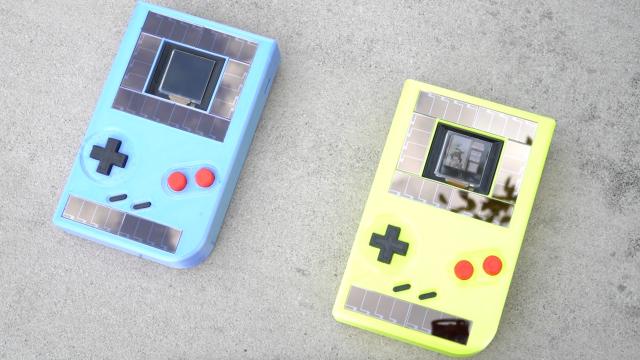The eternal struggle with the original Game Boy was having a cache of batteries on hand. Handheld consoles have evolved since then, but the battery problem still exists. However, researchers from Northwestern University and the Delft University of Technology have created a proof-of-concept “Game Boy” that doesn’t require batteries at all. Instead, it harvests energy from the sun and button-mashing.
Technically, the device isn’t a one-to-one clone of the Game Boy, even though it looks an awful lot like the original. Dubbed the “Engage,” this retro gaming gadget is a clone of the 8-bit Nintendo Game Boy and can even play original cartridges. The main difference is the front outfitted with a set of solar panels. The buttons also act as a secondary energy source. When you press them, it harvests energy from, well, you. Currently, these two sources are enough to power about 10 seconds of play at a time. Once the devices “dies,” you can button mash to revive it. The goal is to one day create a gadget that revives so quickly, you won’t have noticed it switched off in the first place. The concept behind this type of low-power device that harvests energy from non-battery sources is called intermittent computing.
One of the challenges of intermittent computing in gaming is saving progress if your devices switches off every 10 seconds. On old Game Boys, the save system relied on battery power and RAM. When the battery died, save checkpoints also vanished. With the Engage, the researchers figured out a pretty clever workaround. There’s no need to ever hit a save button. Instead, the gadget uses a new technique for storing data that enables it to save and restore your progress in milliseconds. In an interview with CNET, the creators explained the gist of how this works. Once the device detects power is low, it creates checkpoints and only stores “data that has been changed from the previous checkpoint.” The end result is that even if you’re mid-jump in a Super Mario game, you’ll come back to the exact same point when power is restored.
As impressive as this is, there are also limitations. The Engage isn’t able to support sound, as it’s too power-intensive for the device in its current state. The screen is also itty bitty. On top of that, some games work better than others. While things like Chess, Solitaire, and Tetris work pretty well, the researchers say that’s not necessarily true for certain action games. Pokémon, for instance, doesn’t require a whole lot of button pressing. Understandably, the gaming experience also degrades under less-than-ideal lighting conditions.
But why go through the trouble of creating a battery-free console in the first place? The researchers behind the project told CNET that combating climate change was a driving influence behind the project — particularly with regard to the impact video game consoles have on the environment. Energy requirements have grown more intense as consoles become faster and feature more powerful graphics. Rechargeable lithium-ion batteries also require intensive mining that pollutes local water sources, and it’s an unfortunate truth that most consumers do a poor job of recycling old gadgets.
“Sustainable gaming will become a reality, and we made a major step in that direction — by getting rid of the battery completely,” TU Delft’s Przemyslaw Pawelczak, one of the co-leads on the project, said in a statement. “With our platform, we want to make a statement that it is possible to make a sustainable gaming system that brings fun and joy to the user.”
“We’re using capacitors, which are basically just two metal plates. A battery is a chemical factory,” Josiah Hester, co-lead and assistant professor of computer. engineering at Northwestern University, said in a video explaining the project. “Those chemicals will break down eventually. They degrade until they create such a slow voltage that they’re not usable. Whereas with a capacitor you can continuously recharge it millions of millions of times.”
There’s still quite a way to go technologically before you could ever have something like a battery-free Nintendo Switch, but you have to start somewhere. The researchers hope this is a way to kickstart conversations about how to solve some of the current limitations with intermittent computing, as well as study how users interact with these types of devices. To that end, the researchers will be presenting their work at UbiComp 2020 on Sept. 15, and published a technical writeup with a link to the source code on Github.
